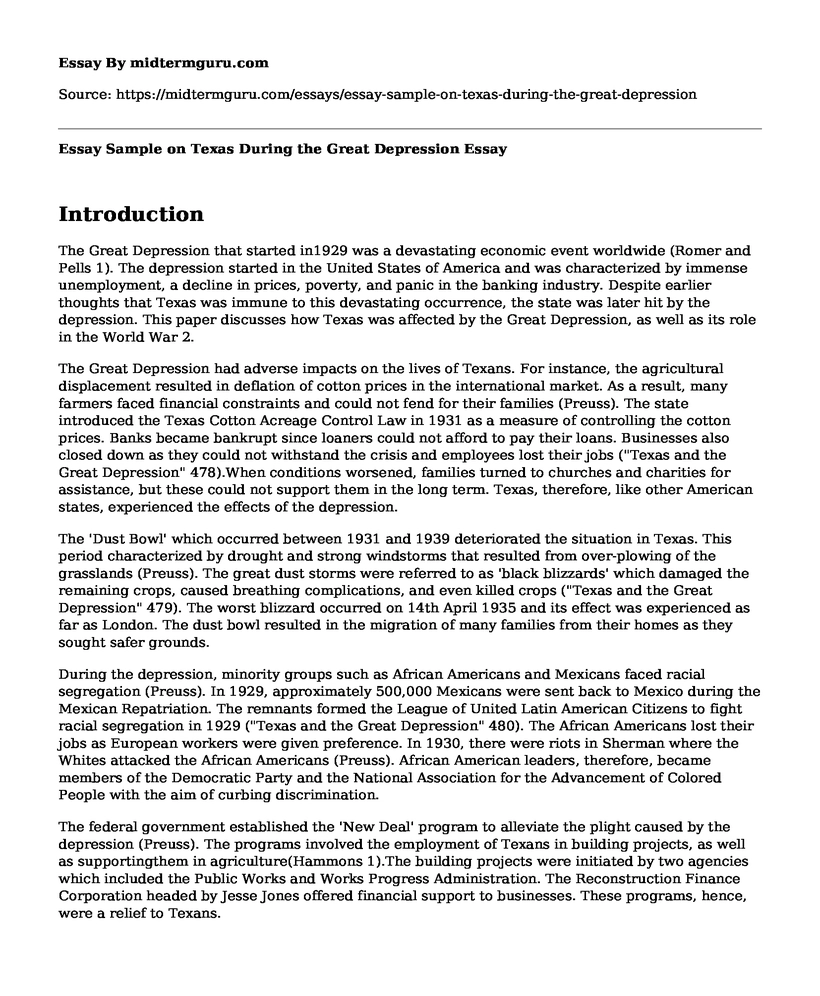Introduction
The Great Depression that started in1929 was a devastating economic event worldwide (Romer and Pells 1). The depression started in the United States of America and was characterized by immense unemployment, a decline in prices, poverty, and panic in the banking industry. Despite earlier thoughts that Texas was immune to this devastating occurrence, the state was later hit by the depression. This paper discusses how Texas was affected by the Great Depression, as well as its role in the World War 2.
The Great Depression had adverse impacts on the lives of Texans. For instance, the agricultural displacement resulted in deflation of cotton prices in the international market. As a result, many farmers faced financial constraints and could not fend for their families (Preuss). The state introduced the Texas Cotton Acreage Control Law in 1931 as a measure of controlling the cotton prices. Banks became bankrupt since loaners could not afford to pay their loans. Businesses also closed down as they could not withstand the crisis and employees lost their jobs ("Texas and the Great Depression" 478).When conditions worsened, families turned to churches and charities for assistance, but these could not support them in the long term. Texas, therefore, like other American states, experienced the effects of the depression.
The 'Dust Bowl' which occurred between 1931 and 1939 deteriorated the situation in Texas. This period characterized by drought and strong windstorms that resulted from over-plowing of the grasslands (Preuss). The great dust storms were referred to as 'black blizzards' which damaged the remaining crops, caused breathing complications, and even killed crops ("Texas and the Great Depression" 479). The worst blizzard occurred on 14th April 1935 and its effect was experienced as far as London. The dust bowl resulted in the migration of many families from their homes as they sought safer grounds.
During the depression, minority groups such as African Americans and Mexicans faced racial segregation (Preuss). In 1929, approximately 500,000 Mexicans were sent back to Mexico during the Mexican Repatriation. The remnants formed the League of United Latin American Citizens to fight racial segregation in 1929 ("Texas and the Great Depression" 480). The African Americans lost their jobs as European workers were given preference. In 1930, there were riots in Sherman where the Whites attacked the African Americans (Preuss). African American leaders, therefore, became members of the Democratic Party and the National Association for the Advancement of Colored People with the aim of curbing discrimination.
The federal government established the 'New Deal' program to alleviate the plight caused by the depression (Preuss). The programs involved the employment of Texans in building projects, as well as supportingthem in agriculture(Hammons 1).The building projects were initiated by two agencies which included the Public Works and Works Progress Administration. The Reconstruction Finance Corporation headed by Jesse Jones offered financial support to businesses. These programs, hence, were a relief to Texans.
Despite the challenges, the Texas Centennial took place in 1936. The state government set apart finances to celebrate the Centennial in Dallas Fair Park. Also, it built state monuments such as the San Jacinto, Alamo Cenotaph, and the Founders' cemetery (Preuss). County markers were also set up in every county. There was the formation of music groups in the state, for example, the 'Light Crust Doughboys' created by Lee O' Daniel. One of the group members, Bob Willis, later started a radio show while O' Daniel became a governor, and finally a senator in 1941.
World War 2 alleviated some effects of the depression in Texas. Due to its ideal location, Texas became the United States' industrial and military center (Hammons 1). Industrialization helped in recovering the economy, especially through shipbuilding and petroleum (Preuss). Many Texans were enlisted to join the military and formed about 7% of the forces. The establishment of 15 military training camps in Texas also boosted its economy. Minority groups benefitted by working in factories as Anglo males fought abroad. African Americans and Mexicans also, were later allowed to join the military though in segregated camps. The end of the war marked a new beginning as minority groups were determined to fight against discrimination, and Texas enjoyed economic growth.
Conclusion
In conclusion, the Great Depression was a devastating period, especially in America. It was characterized by a financial crisis that was widespread across its states, including Texas. The depression had adverse effects on Texas and it was deteriorated by the Dust Bowl in 1931. The federal government established new deal programs to alleviate the financial situation. WhenWorld War 2 started, Texas experienced economic growth as it was well-situated as a military and industrial center. The war, therefore, contributed significantly to the end of the Great Depression.
Works Cited
Hammons, C. "The Great Depression and World War II 1930-1945" https://texasourtexas.texaspbs.org/the-eras-of-texas/great-depression-ww2/.Accessed 14 November 2018.
Romer, Christina D. and Pells, Richard H. "Great Depression".Encyclopedia Britannica.https://www.britannica.com/event/Great-Depression/Causes-of-the-decline. Accessed 14 November 2018.
"Texas History Lecture 12: Texas Depression to WWII." Youtube, Uploaded by Gene Preuss, 26 July 2011, https://www.youtube.com/watch?v=M9RObMoETm4.
"Texas and the Great Depression".NEISD Library https://www.neisd.net/cms/lib/TX02215002/Centricity/Domain/3751/Pictures/textbook/Chapter%2023%20Sec%201.pdf.Accessed 14 November 2018.
Cite this page
Essay Sample on Texas During the Great Depression. (2022, Oct 04). Retrieved from https://midtermguru.com/essays/essay-sample-on-texas-during-the-great-depression
If you are the original author of this essay and no longer wish to have it published on the midtermguru.com website, please click below to request its removal:
- Essay on the First World War: How Imperialism Caused the First World War
- What Happened to Abigail Williams - Essay Sample
- Paper Example on Ancient China
- Paper Example on Ida Wells Jr and Martin Luther: Fight for Justice
- Essay Sample on Abraham Lincoln as a Reflection of Culture and the Time He Existed
- Drama of the Alexander Hamilton During His Reign as the Secretary to the Treasury - Research Paper
- Movie Analysis Essay on The Spy Who Came in From the Cold







